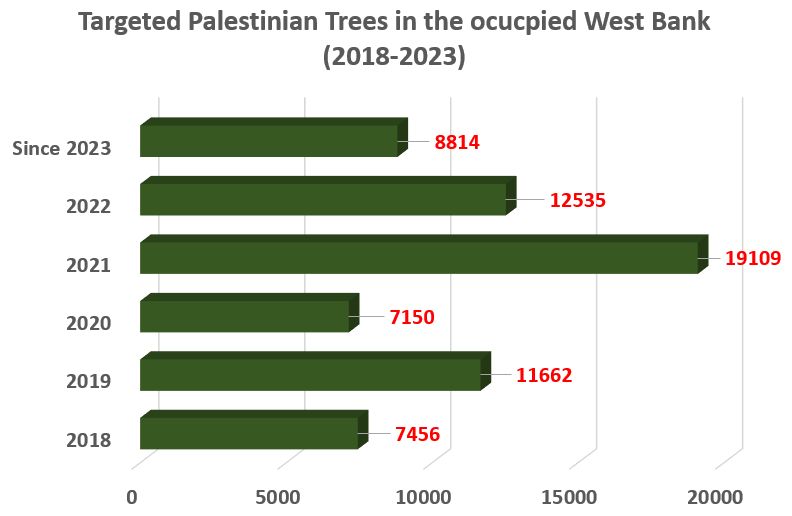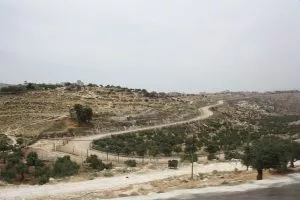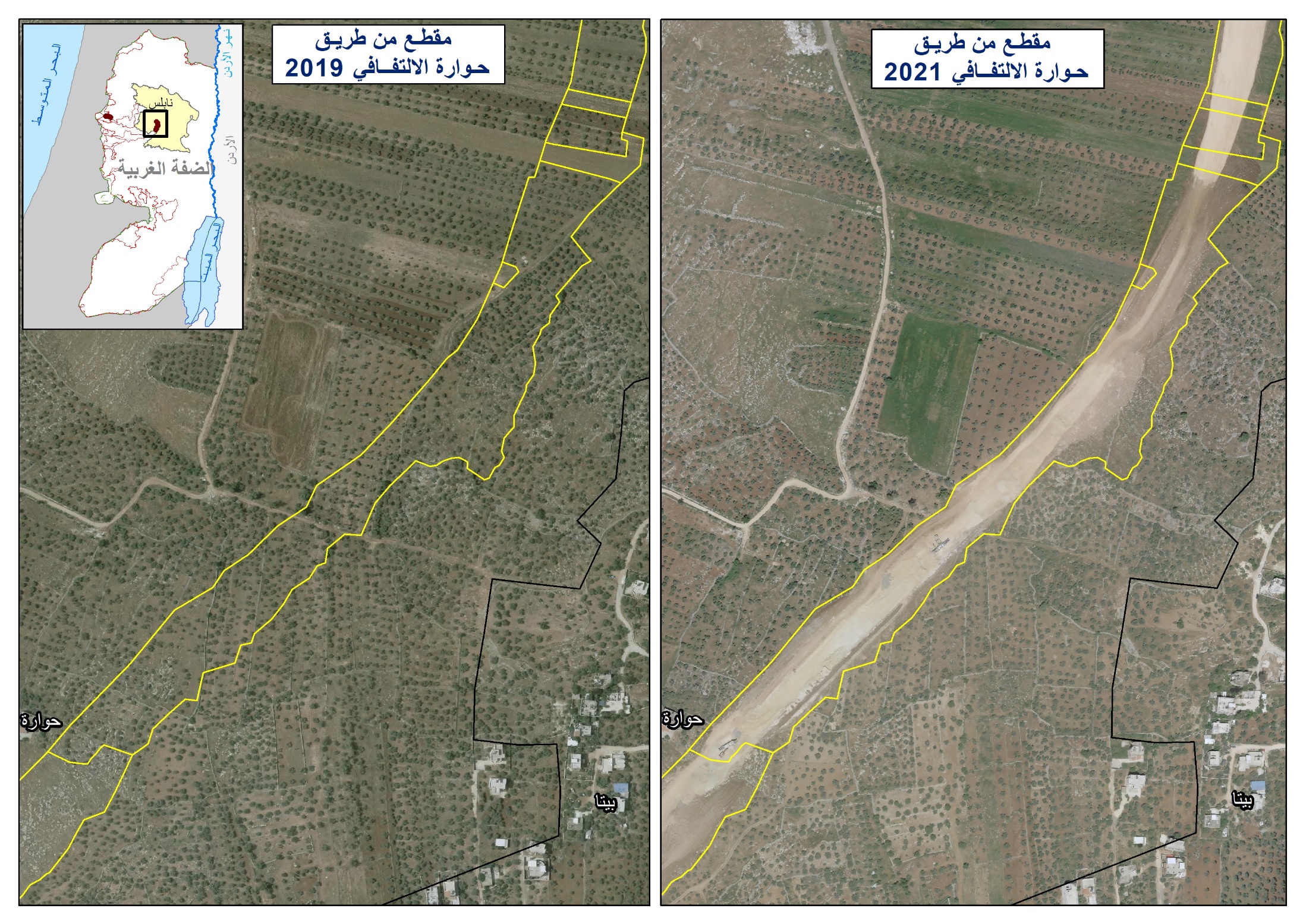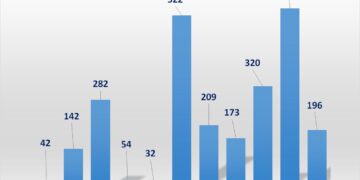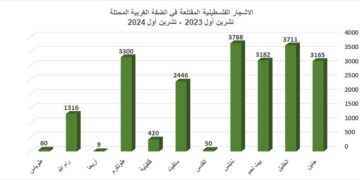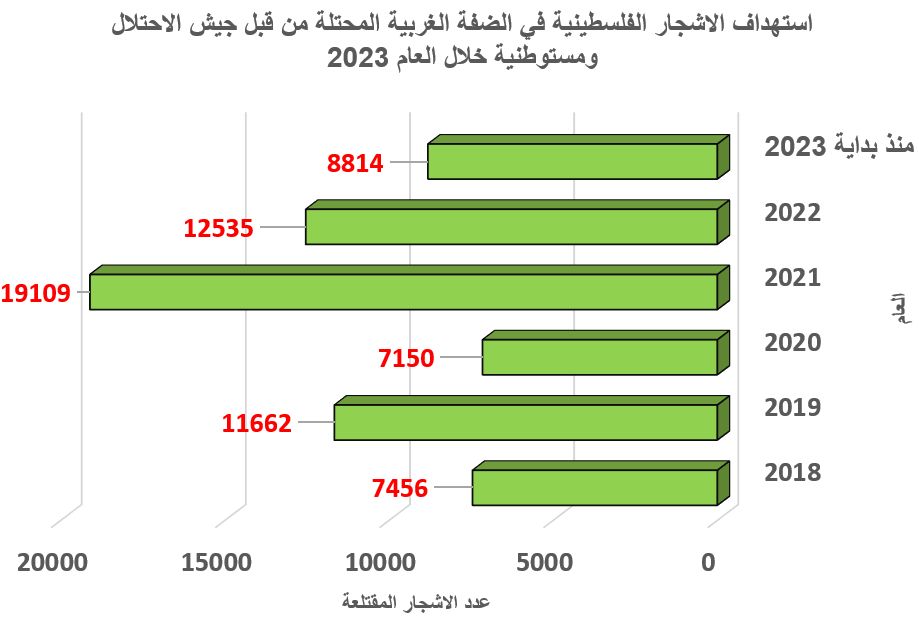The year 2023 is expected to witness an exceptionally poor olive harvest season in the occupied Palestinian territory. This aligns with increased Israeli aggression in the occupied Gaza Strip, and the implementation of a strict siege on the occupied West Bank Governorates, which involved the erection of over 120 new Israeli military checkpoints, a rise in the number of attacks by Israeli occupation forces and settler groups, and the fragmentation of land. Palestinian farmers in the occupied West Bank have also encountered significant obstacles in reaching their olive groves, particularly in areas surrounding Israeli settlements and outposts. Furthermore, Palestinian landowners have been denied access to their isolated lands, west of the separation wall, to harvest their olive fields.
According to the Palestinian Ministry of Agriculture, the olive oil industry constitutes 25% of the total agricultural income in the occupied Palestinian territory and contributes to the livelihoods of over 96,000 families. The expected total production for this season is 12,000 tons of oil, representing a significant 67% decrease compared to the previous year’s total production of 36,000 tons. This decrease is attributed to climate change, recent fluctuations in weather, and the Olive Tree Alternate Bearing. The expected total for the present year is not sufficient to cover the annual consumption of oil in occupied Palestine, where the local Palestinian market typically requires around 18,000 tons of olive oil annually, with an estimated per capita consumption ranging from 3 to 3.5 kilograms. To make up for the shortages, Palestinians will need to import olive oil from outside markets.
In the besieged Gaza Strip, it was expected that nearly 1,500 to 2,000 tons of olive oil would be produced; however, due to the Israeli aggression on the Gaza Strip since the 7th of October 2023, and the continuous bombardment on lands and properties, Palestinian farmers were unable to harvest their olive trees; the Gaza Strip also experienced severe cuts in electricity and water supply, coupled with restrictions on fuel entry which in turn, prevented Gazans from operating the 40 olive oil presses in the Gaza Strip.
The Israeli separation wall also has a direct impact on the Olive Harvest Season in the occupied West Bank. Palestinian farmers usually need special permits or prior coordination with Israeli occupation authorities to access their agricultural lands located between the separation wall and the Green Line (the 1949 Armistice Line), known as the “Western Segregation Zone” or the “closed area”. The approval rate by the Israeli authorities for Palestinians’ permit requests during the olive harvesting season in recent years typically ranges between 50 and 60 percent. For those who obtain permits, they enter the “closed area” through approximately 85 designated gates along the path of the separation wall to access their agricultural lands.
Photo 1-2: A view of some of the segregated Olive Grooves in the oWB (ARIJ Archive)
Yet, as a result of the current political situation in the Gaza Strip, Israel has intensified the blockade on the occupied West Bank, leading to the closure of major roads and entrances to Palestinian communities. This has consequently impacted Palestinian farmers’ access to their agricultural lands located west of the separation wall and in close proximity of Israeli settlements and outposts.

Map 1: Palestinian lands cultivated with olive trees in the occupied West Bank.
Palestinian farmers in almost 90 communities in the oWB, who own lands in close proximity to 56 Israeli settlements and outposts, cannot access their lands except through prior coordination with the Israeli occupation authorities and only for a limited number of days, during the harvest and plowing seasons.
The area of Palestinian land cultivated with olive trees west of the Israeli separation wall (Known as the Seam Zone) is approximately 88,000 dunums, constituting roughly 15.3% of the total agricultural land planted with olive trees in occupied Palestine, which is around 575,000 dunums (and 85% of the total orchard area; with 552,534 dunums in the occupied West Bank and 22,633 dunums in the besieged Gaza Strip), (PCBS, 2021).
Under normal circumstances, Israeli restrictions imposed on areas west of the separation wall, limit Palestinians’ access to their lands and hinder essential agricultural activities such as plowing, pruning, fertilizing, pest control, and dealing with undesired plants which further impacts the productivity and value of olives.
Data collected by United Nations Office for the Coordination of Humanitarian Affairs (OCHA) indicates that olive trees in the area between the separation wall and the Green Line (the 1949 Armistice Line) have experienced a nearly 60% reduction in Olive production compared to similar trees on the eastern side of the separation wall.
Israeli settlers have also undermined the olive-dependent livelihoods in various areas of the occupied West Bank by uprooting, damaging, and burning of Palestinian olive trees. Settlers, guarded by the Israeli occupation army, uprooted over 8,800 olive trees and saplings this year alone (2023). Palestinian farmers in communities namely Yasuf, Iskaka, and Kafr al-Dik in the Salfit governorate were prevented from harvesting their olives, and were targeted by settlers’ live bullets. Similar incidents occurred in many other Palestinian communities in the northern West Bank, such as Qabalan, Yanun, and Awarta communities in Nablus governorate; Zububa and Jalbun communities in Jenin governorate. Incidents of settlers stealing the Olive fruits, especially in areas restricted to Palestinian access were also recorded .
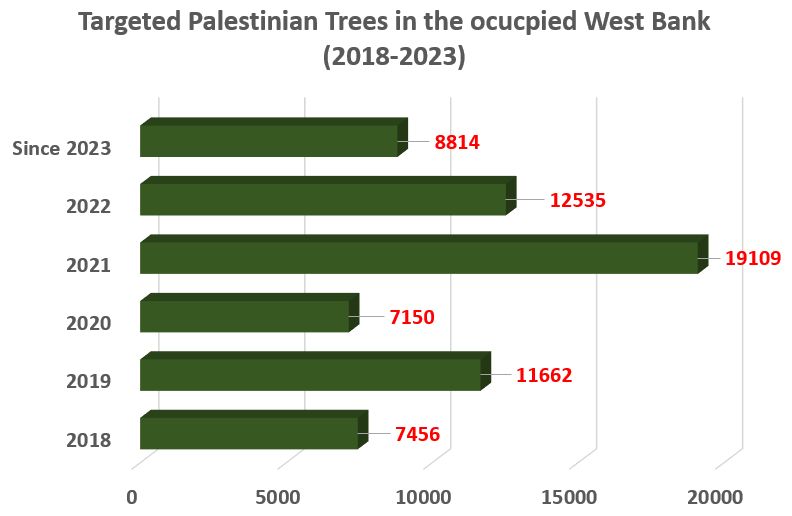
Chart No. 1: Uprooted, burned, and vandalized Palestinian trees in the occupied West Bank over the past years.
Under international law, Israel, as an occupying power, is obligated to protect Palestinian civilians and their property . It must ensure the safe and unrestricted access of Palestinian farmers to their agricultural lands throughout the year and hold those responsible for the attacks accountable.
In conclusion,
Given the current season’s expected decline and due to the ongoing Israeli measures in the occupied Gaza Strip, along with the strict procedures imposed on the occupied West Bank, the expected total quantity of olive production in occupied Palestine is 9,500 tons, a decrease of 21% from the estimated quantity before the 7th of October 2023, (which is 12,000 tons). This quantity is equivalent to 2,591 tons of olive oil, with an estimated value of about 21 million US dollars.”
Consequently, Palestinians will need to address the deficit in olive oil either by purchasing large quantities of previous season’s olive oil, coping with the quantities produced this year, or the Palestinian Authority might need to consider restricting the export of olive oil to outside markets to avoid the exploitation of local market demand. This measure, in effect, would influence the current olive oil prices, leading to an increase due to high demand and limited available quantities.
Prepared by:
The Applied Research Institute – Jerusalem


